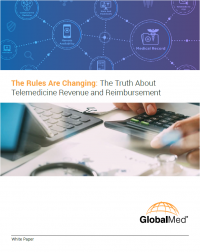
It’s November and that means it’s National Diabetes Month. Most people have some awareness of what diabetes is; many have family members or friends with Type 1 or Type 2 diabetes. But what isn’t as well known is how telemedicine is helping patients manage their condition – and even saving their lives in the COVID-19 pandemic.
Dr. David G. Marrero, director of the University of Arizona Health Sciences Center for Border Health Disparities in Tucson, says, “Diabetes may be the most serious public health crisis of our time.” Consider that:
- An estimated 30 million Americans live with diabetes.
- More than 84 million are at risk of acquiring diabetes.
- Adults with diabetes are almost twice as likely to die from heart disease or stroke and can experience kidney failure, blindness, amputation, and depression.
- Over 83,000 people die of diabetes each year.
This year has added another dire consequence – the reality that diabetic patients frequently experience worse complications from COVID-19. Clinicians have repeatedly observed that infected patients with diabetes are more likely to suffer more severe symptoms. Any comorbidities like heart disease can make it harder for them to fight the infection. Viral infections and high blood sugar can work together to increase inflammation in people with diabetes; if infected, they also face an increased risk of diabetic ketoacidosis (DKA), which can make it tough for them to control their fluid intake and electrolyte levels – a key factor in managing sepsis, a serious COVID-19 complication.
Controlling the Diabetes Crisis
The good news is that diabetics can be natural telemedicine adopters. While many patients have yet to dip their toes in the telehealth water, patients with diabetes are already active participants in their own care plans. Many inject themselves with insulin or monitor their blood sugar levels at home and remotely share the results. Progressing to other forms of virtual care can feel like a natural next step.
Fortunately, telemedicine offers 7 convenient and clinically responsible advantages when it comes to managing diabetes:
- Consistent monitoring. Blood sugar spot checks offer just a momentary glimpse into a patient’s ongoing status. Telehealth can enable round-the-clock monitoring, giving providers a 24-hour profile and a better understanding of the patient’s condition.
- Support for lifestyle modifications. An American Diabetes Association study found that digital health tools can help patients lose weight, lower blood pressure, and follow other healthy behaviors that can curb diabetes. Patients can even connect with support groups from their own homes, sharing fitness and nutritional advice to improve wellness.
- Patient engagement. Compliance with treatment plans can make or break a patient’s improvement. Telehealth especially in combination with connected devices enables patients to participate in their own care from home and allows clinicians to remotely observe a diabetic’s condition and progress – helping the patient stay on track.
- Depression treatment. People with diabetes are at least twice as likely to suffer from depression as non-diabetics. Often the link between diabetes and depression functions as a cycle, with low blood sugar creating a feeling of malaise and lethargy that can then contribute to poor eating habits, lack of exercise, and self-neglect. Behavioral health counselors and coaches can virtually treat depression and encourage lifestyle changes.
- Preventive programs. The Centers for Disease Control and Prevention (CDC) is trying to stop at-risk people from developing type 2 diabetes through their National Diabetes Prevention Programs (DPP). The program offers group sessions that focus on long-term dietary change, increased exercise, and weight control strategies. Telehealth helps providers deliver DPP programs to rural areas without specialized diabetes expertise. Coordinators can share online patient education materials and measure each participant’s physical activity and weight loss progress.
- Cost control. Diabetes imposes a staggering economic burden on our healthcare system. The American Diabetes Association estimated that the cost of diagnosed diabetes in the U.S. hit $327 billion in 2017, with reduced productivity costing another $90 billion. As Dr. Marrero said, “If you think our healthcare system is stressed now and that the costs are exacerbated, put another 40 to 50 million people with diabetes into the mix, and we’ll be in very deep trouble.”
- COVID-19 prevention and treatment. The same self-use blood glucose meters used at home by patients are now being used by in the hospital to reduce patient interactions with providers. Not only does this limit exposure to COVID-19, it helps providers ration their personal protective equipment (PPE). The meters’ built-in wireless data transmission capabilities increase provider insights and help them better manage their patients’ conditions – reducing their likelihood of becoming seriously ill from COVID-19.
Opening a Virtual Door to Diabetes Care
Recently 19 U.S. senators asked CMS and Health and Human Services Secretary Alex Azar to reimburse telemedicine services to improve outcomes for Americans at risk of developing type 2 diabetes. Their letter stated, “A Medicare beneficiary’s access to the life-improving program should not, and cannot, be determined solely by the zip code in which he or she lives.”
That’s actually the telemedicine philosophy for all healthcare needs for all patients. So the fact that more leaders are seeing virtual care benefits, regardless of specialty, is exciting. Let’s hope more providers use telemedicine to reach more patients with diabetes before the current crisis gets worse.


Thanks for providing this wonderful information. Telemedicine can help both patients to control their diabetes and doctors to treat people diagnosed with diabetes. It can upload information of medications to take, prescribed dosage and blood sugar levels for review by a nurse or doctor who responds electronically. This is how telemedicine can help in controlling diabetes. Your article is very informative.